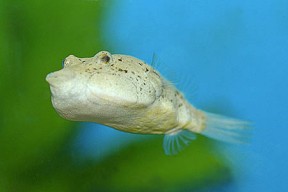Tetraodon miurus
Congo Puffer
Classification
Tetraodontidae
Distribution
Republic of Congo, Democratic Republic of Congo.
Habitat
It lives in large rivers and can sometimes be found in areas of considerable flow, even rapids.
Maximum Standard Length
6″ (15cm).
Aquarium SizeTop ↑
30″ x 12″ x 12″ (75x12x12cm) – 70 litres is fine as this is not a particularly active fish.
Maintenance
This is a freshwater puffer and does not require the addition of salt to its tank. What is essential, is the provision of a deep (2-3″) bed of sand as substrate. This will allow the fish to exhibit its natural behaviour (see below). Provide additional cover in the form of smooth rocks (interestingly the puffer will often attempt to mimic these), and driftwood pieces. Plants can also be used if you wish.
Water Conditions
Temperature: 75-82°F (24-28°C)
pH: 6.8-7.5
Hardness: 10-15°H
Diet
An ambush predator in nature, T. miurus requires a meaty diet. Offer prawns, earthworms, lancefish, mussel etc. Some specimens may initally only take live foods but most will take dead alternatives.
Behaviour and CompatibilityTop ↑
It is not really safe to house this species with anything else! It is a voracious predator that will eat any fish it can fit in its mouth, and will usually take chunks from larger tankmates. It is also completely intolerant of conspecifics. Some aquarists have had success keeping it with armoured Loricariids.
Sexual Dimorphism
Unknown.
Reproduction
It has not been bred in captivity.
NotesTop ↑
Puffer fish are so called as they have the ability to inflate their elastic stomachs with water or air. This is usually a response to some kind of threat, although in the aquarium many specimens appear to inflate themselves for no apparent reason. The fish becomes 2 or 3 times its normal size, big enough to scare away many potential predators, or difficult to swallow.
Puffers also have several other interesting adaptations. They are one of the few fish that can actually blink or close their eyes, which only serves to add further charm to what is already a fish with bags of character. They also have beak-like mouthparts, which are formed by a fusing of 2 teeth from each jaw (hence Tetraodon). These are used to crush shelled invertebrates, the favourite food of most puffers.
Many parts of the body of puffers contain the deadly neurotoxin tetrodoxin. This is the same poison found in the notorious blue-ringed octopus. When ingested in sufficient quantities, it can cause paralysis and death. As yet, there is no known antitoxin and to humans it is over 1000 times deadlier than cyanide. Grotesquely, the victim usually remains conscious as he or she becomes paralysed. It’s a famous delicacy in Japan, but is prepared only by highly-trained chefs, and even then many people have died from eating it. This need not worry you, but if you need to get rid of your puffer, sell it on: getting the barbecue out is not recommended!
T. miurus is a real oddball and is not recommended to the general aquarist, due to its nasty disposition. In a species tank however, it will show some interesting behaviour. It is a true ambush predator, spending most of its time buried in the substrate, lying in wait for potential food. It can also make itself resemble an algae-covered rock, if the substrate is not soft or deep enough to dig into. Its eyes are located on the top of it’s head, and its mouth is upturned to assist in attacking prey items from below. It can also produce some surprising changes of colour, being able to take on deep red and orange colours depending on it’s mood.






November 5th, 2018 at 4:05 am
I own one of these guys and they are truly awesome. His name is Quagmire (given the squared-out jaw.) If you’re not keen on the idea of the fish being a “solo act” I’d definitely tell you to reconsider! They have so much personality that it is downright ridiculous. Mine has a very sweet temperament, to the point that he’ll lay in my hand. If you talk to them/wave they typically come bursting out of the sand and wiggle around the tank. They’re pretty much a dog in a fish’s body. If you can get a hold of one, you won’t regret it!
January 30th, 2019 at 9:55 am
Hey ! 🙂
Just notice you forgot the conversion in the aquarium size : 12″/12cm.
And thank for this amazing work 🙂